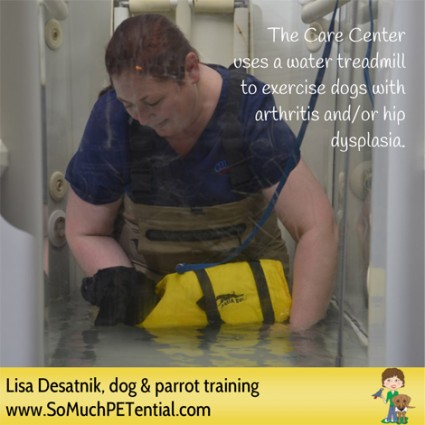Do you know what hip dysplasia is in dogs? And what types of exercise can help a dog that has it? I spoke with Physical Therapist Ginger Jones, CCRP, at Care Center Animal Hospital in Cincinnati about the symptoms of canine hip dysplasia and some helpful exercises for dogs.
 Hip dysplasia is one of the most skeletal diseases in dogs. It is an abnormal formation of the hip joint, which includes a ball and socket, and which can lead to gradual deterioration and loss of function.
Hip dysplasia is one of the most skeletal diseases in dogs. It is an abnormal formation of the hip joint, which includes a ball and socket, and which can lead to gradual deterioration and loss of function.
While any dog can develop it. Large and giant breeds such as German Shepherds, Labrador Retrievers, Saint Bernards, and Great Danes have likelier genetic predispositions to it.
Here are some symptoms to watch for:
- Difficulty rising from a seated or laying down position
- Reluctance to climb stairs, jump or run
- Pain in hip joints
- Having back legs unnaturally close together
- Decreased muscle mass in the thighs
- Enlarged shoulder muscles from bearing more weight on the front legs
- Decreased activity
- Lameness
- Shifting their whole back end to move their back legs
“As soon as you learn your dog has it, it is important to begin exercises to strengthen muscles and stabilize the joint,” Ginger said.
Types of exercises recommended by Ginger for dogs with hip dysplashia:
- Incorporate into your walks going uphill some so as to shift his weight to his back legs to strengthen those muscles.
- Practice sitting and getting back up for both strengthening muscles and stability. It is important to begin with a small number of sits in the beginning and gradually increase that.
- If your dog has not had surgery, be careful with jumps as the pushing off can be painful; however, you can gradually build up to running some. Ginger recommends beginning with three 5 minute walks, adding a couple minutes daily each week. Once you get to a 20 minute walk, THEN she said you can initiate some jogging. “It is okay to run some as long as you build up to it first,” Ginger told me.
- Swimming and walking on a water treadmill are good exercises.
- Pushing a ball is a good exercise as it requires your dog to hold his head down, which takes the weight off of his hips and not all exercise should be about adding weight to the hips.
- Doing an activity that requires your dog to move his head from side to side also helps with stability and core strength as he shifts his body weight with the movement.
- Balance exercises are great. Smaller dogs can stand on a Bosu ball and practice shifting their weight from right to left. You can also practice having your dog raise one front paw and then the other, and practice walking on uneven surfaces.
- An exercise to avoid is agility as this requires too much fast paced, quick directional change movement.
- For front limbs, walking is important. Giving your dog a treat ball will cause your dog to lower his head and put more weight on his front limbs. You can also put something on your dog’s nose, which will encourage him to use his front limbs to get it off. Walking downhill is also good for front leg work.
- Caveletti exercises are good for arthritis and hip dysplasia as they increase the range in the front and hind limbs, increase flexion, and is good for placement of the feet and balance, and core strength. You want to start at a very low height and build it up. Six caveletties is a good number for that.
Some other additional tips Ginger suggested:
- A good, well cushioned orthopedic bed goes a long way. For larger dogs who don’t want to lay on a bed due to its warmth, you may want to buy a cooling mat.
- A slick surface is more difficult for your dog to move on and may limit his mobility further. Area rugs, gym or yoga mats placed on wood floors will be helpful.
- Extra weight means more pressure on those joints so if your dog is some extra pounds, consider putting him on a diet.
- With arthritis, the best modality is heat. Before any exercise, Ginger recommends putting a heated rice bag on your dog’s problem joint and doing some warm up exercises before a walk.
- Your vet may recommend anti-inflammatory supplements.






